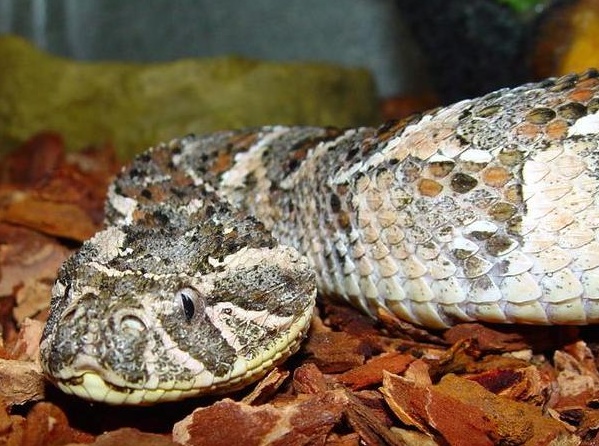- Bitis
Taxobox
name = "Bitis"

image_caption = Puff adder, "B. arietans".
regnum =Animal ia
phylum =Chordata
subphylum = Vertebrata
classis =Reptilia
ordo =Squamata
subordo = Serpentes
familia =Viperidae
subfamilia =Viperinae
genus = "Bitis"
genus_authority = Gray, 1842
synonyms = * "Cobra" - Laurenti, 1768
* "Echidna" - Merrem, 1820
* "Clotho" - Gray, 1842
* "Bitis" - Gray, 1842
* "Echidne" - Duméril & Bibron, 1844
* "Hallowellius" - Reus, 1939
* "Macrocerastes" - Reus, 1939McDiarmid RW, Campbell JA, Touré T. 1999. Snake Species of the World: A Taxonomic and Geographic Reference, vol. 1. Herpetologists' League. 511 pp. ISBN 1-893777-00-6 (series). ISBN 1-893777-01-4 (volume).] :"Common names: puff adders, African adders,Mallow D, Ludwig D, Nilson G. 2003. True Vipers: Natural History and Toxinology of Old World Vipers. Krieger Publishing Company, Malabar, Florida. 359 pp. ISBN 0-89464-877-2.] African vipers.Spawls S, Branch B. 1995. The Dangerous Snakes of Africa. Ralph Curtis Books. Dubai: Oriental Press. 192 pp. ISBN 0-88359-029-8.] ""Bitis" is agenus of venomous vipers found inAfrica and the southernArabian Peninsula . It includes the largest and the smallest vipers in the world. Members are known for their characteristic threat displays that involves inflating and deflating their bodies while hissing and puffing loudly. Thetype species for this genus is "B. arietans", which is also the most widely distributed viper in Africa. Currently, 14species are recognized.ITIS|ID=634420|taxon="Bitis"|year=2006|date=18 July]Description
Size variation within this genus is extreme, ranging from the very small "B. schneideri", which grows to a maximum of 28 cm and is perhaps the world's smallest viperid, to the very large "B. gabonica", which can attain a length of over 2 m and is the heaviest viper in the world.
All have a wide, triangular head with a rounded snout, distinct from the neck, and covered in small, keeled, imbricate scales. The canthus is also distinct. A number of species have enlarged rostral or supraorbital scales that look like horns. The eyes are relatively small. They have large nostrils that are directed outwards and/or upwards. 0-6 rows of small scales separate the rostral and
nasal scales . All species have a well-developed supranasal sac. The front of the maxillary bones are very short, supporting only one pair of recurved fangs.U.S. Navy. 1965. Poisonous Snakes of the World. US Govt. Printing Office, Washington D.C. 212 pp.]These snakes are moderately to extremely stout. The body is covered with keeled scales that are imbricate with apical pits. At midbody, the
dorsal scales number 21-46. Laterally, the dorsal scales may be slightly oblique. Theventral scales , which number 112-153, are large, rounded and sometimes have slight lateral keels. The tail is short.Anal scale single. The pairedsubcaudal scales number 16-37 and are sometimes keeled laterally.Geographic range
Africa and the southernArabian Peninsula .Behavior
"Bitis" species are known for their behavior of inflating and deflating their bodies in loud hissing or puffing threat displays. They are terrestrial ambush predators and appear sluggish, but can strike with amazing speed. In contrast to the pitvipers of the subfamily
Crotalinae , "Bitis" species appear to lack heat-sensitive organs and showed no differences in their behavior in laboratory tests towards warm and cool objects that mimicked prey. [cite journal |author=Safer AB, Grace MS |title=Infrared imaging in vipers: differential responses of crotaline and viperine snakes to paired thermal targets |journal=Behav. Brain Res. |volume=154 |issue=1 |pages=55–61 |year=2004 |pmid=15302110] [cite journal |author=Krochmal AR, Bakken GS, LaDuc TJ |title=Heat in evolution's kitchen: evolutionary perspectives on the functions and origin of the facial pit of pitvipers (Viperidae: Crotalinae) |journal=J. Exp. Biol. |volume=207 |issue=Pt 24 |pages=4231–8 |year=2004 |pmid=15531644 |url=http://jeb.biologists.org/cgi/pmidlookup?view=long&pmid=15531644 |doi=10.1242/jeb.01278]Reproduction
All members are
viviparous and some give birth to large numbers of offspring.Venom
All members of this genus are dangerous — some extremely so. At least six different polyvalent antivenoms are available. Five are produced by Aventis Pasteur (France), Pasteur Merieux (France) and SAIMR (South Africa). All of these specifically protect against "B. arietans" and four also cover "B. gabonica". [http://www.toxinfo.org/antivenoms/indication/BITIS_ARIETANS.html "Bitis arietans" antivenoms] at [http://www.toxinfo.org/antivenoms/ Munich AntiVenom INdex] . Accessed 25 August, 2006.] [http://www.toxinfo.org/antivenoms/indication/BITIS_GABONICA.html "Bitis gabonica" antivenoms] at [http://www.toxinfo.org/antivenoms/ Munich AntiVenom INdex] . Accessed 25 August, 2006.] At least one protects specifically against bites from "B. nasicornis": India Antiserum Africa Polyvalent. [http://www.venomousreptiles.org/pages/antbnk Miami-Dade Fire Rescue Venom Response Unit] at [http://www.venomousreptiles.org/ VenomousReptiles.org] . Accessed 5 September 2006.] In the past, such antivenoms have been used to treat bites from other "Bitis" species, but with mixed results.
pecies
"*) Not including the nominate subspecies."
T")Type species .Taxonomy
Other species may be encountered in literature, such as:
* "B. albanica" - Hewitt, 1937
* "B. armata" - Smith, 1826Lenk et al. (1999) used molecular data (immunological distances and mitochondrial DNA sequences) to estimate the phylogenetic relationships among species of "Bitis". They identified four major monophyletic groups for which they created four subgenera:
* "Bitis" - "B. arietans"
* "Calechidna" - "B. albanica", "B. armata", "B. atropos", "B. caudalis", "B. cornuta", "B. heraldica", "B. inorata", "B. peringueyi", "B. rubida", "B. schneideri", "B. xeropaga"
* "Macrocerastes" - "B. gabonica", "B. nasicornis", "B. parviocula"
* "Keniabitis" - "B. worthingtoni"For now, this division is of little consequence as far as the nomenclature is concerned. However, the definition of subgenera within a genus is often the sign of an impending split. Therefore, anyone interested in these snakes would do well to familiarize themselves with these new subgenera.
ee also
*
List of viperine species and subspecies
*
*
*Snakebite References
Further reading
* Branch WR. 1999. Dwarf adders of the Bitis cornuta-inornata complex (Serptentes: Viperidae) in Southern Africa. Kaupia (Darmstadt) (8): 39-63.
* Lenk, P., H.-W. Herrmann, U. Joger, & M. Wink (1999) Phylogeny and taxonomic subdivision of "Bitis" (Reptilia: Viperidae) based on molecular evidence. Kaupia, 8: 31-38.
* U.S. Navy. 1991. Poisonous Snakes of the World. New York: Dover Books. (Reprint of US Govt. Printing Office, Washington D.C.) 232 pp. ISBN 0-486-26629-X.External links
*
* [http://www.arkive.org/species/GES/reptiles/Bitis_armata/ Southern adder ("Bitis armata")] at [http://www.arkive.org/ ARKive] . Accessed5 October 2006 .
Wikimedia Foundation. 2010.
